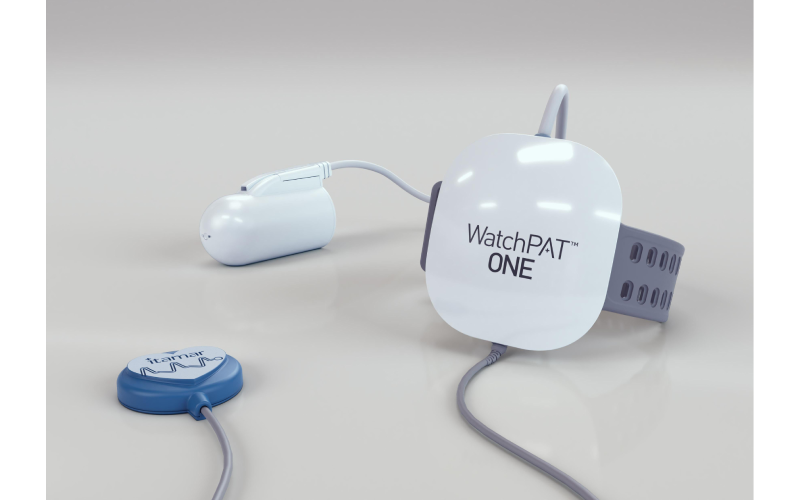WatchPAT One is a nifty device for sleep monitoring, aiming to help with diagnosing sleep apnea and other related sleep disorders. It’s comfortably worn on the wrist and works by combining two key components: the wrist unit that tracks pulse oximetry and heart rate, along with a finger sensor measuring peripheral arterial tone (PAT). This tool collects vital data while you sleep—like oxygen levels, heart variability, and even different sleep stages. It’s quite easy for users; just set it up at home without needing supervision. Once the data’s collected, it gets sent to a cloud platform for analysis, offering detailed reports that aid healthcare providers in assessing sleep quality efficiently.
1. Overview of WatchPAT One Device
WatchPAT One is a convenient device designed for monitoring sleep patterns, particularly for diagnosing conditions like sleep apnea. This portable device is worn on the wrist and makes overnight sleep studies much simpler for users. It consists of two main parts: the wrist unit, known as WatchPAT, and a finger sensor called PAT. While the wrist unit captures vital statistics such as heart rate, oxygen levels, and movement, the finger sensor specifically measures peripheral arterial tone, a key metric for evaluating sleep apnea.
During a night’s sleep, WatchPAT One gathers various physiological data, including oxygen saturation levels, heart rate variability, and different sleep stages—light, deep, and REM. This data collection happens without the need for a sleep lab, allowing patients to comfortably monitor their sleep at home. Users simply follow straightforward setup instructions, ensuring they can wear the device overnight without professional assistance.
The technology behind WatchPAT One is particularly noteworthy. It uses the PAT signal to monitor blood flow changes in the peripheral arteries, effectively detecting sleep apnea events. This integration of multiple signals provides a comprehensive understanding of sleep quality and disturbances. After a night’s data is collected, it is sent to a cloud-based platform where advanced algorithms analyze it. Healthcare providers then receive detailed reports highlighting key metrics, such as the apnea-hypopnea index and overall sleep quality, which assist in diagnosing and treating sleep disorders.
Overall, WatchPAT One stands out as a non-invasive, cost-effective solution for sleep monitoring. Its simplicity and clinical validation make it a reliable choice for both patients and healthcare professionals.
2. Key Components of WatchPAT One
WatchPAT One is made up of two main components: a wrist unit and a finger sensor. The wrist unit, known as WatchPAT, is worn on the wrist and gathers crucial data like pulse oximetry, actigraphy, and heart rate. This data helps in monitoring overall health during sleep. On the other hand, the finger sensor, which fits snugly on the index finger, measures peripheral arterial tone (PAT). This measurement is particularly significant as it plays a vital role in identifying sleep apnea by tracking changes in blood flow.
Together, these components work seamlessly to collect data on various physiological parameters while you sleep. This includes your oxygen saturation levels, heart rate variability, and even the different stages of sleep such as light, deep, and REM sleep. Additionally, it monitors your movement and activity levels throughout the night.
The design of WatchPAT One emphasizes user-friendliness, allowing patients to conduct sleep studies in the comfort of their own homes without the need for professional supervision. Setup is straightforward, requiring users to simply attach the finger sensor and secure the wrist unit before going to bed. This ease of use is crucial for encouraging compliance and ensuring accurate data collection.
3. How WatchPAT One Collects Data
WatchPAT One collects a range of data through its two main components: the wrist unit and the finger sensor. The wrist unit measures vital metrics such as heart rate, oxygen saturation, and movement using pulse oximetry and actigraphy. The finger sensor, placed on the index finger, is crucial as it gauges peripheral arterial tone (PAT), which plays a significant role in identifying sleep apnea events. Throughout the night, the device continuously tracks these parameters, offering insights into different sleep stages including light, deep, and REM sleep. This comprehensive data collection allows WatchPAT One to paint a detailed picture of a person’s sleep patterns, helping to identify disturbances that may indicate sleep disorders. For example, if a user experiences frequent drops in oxygen levels or irregular heart rates, these metrics can signal potential sleep apnea, providing essential information for diagnosis and treatment.
- Utilizes a painless finger sensor for accurate measurement.
- Monitors heart rate variability during sleep.
- Tracks oxygen saturation levels throughout the night.
- Captures sleep stages including REM, light, and deep sleep.
- Records movement patterns to assess sleep disruptions.
- Compiles data into easy-to-understand metrics for users.
4. User-Friendly Experience with WatchPAT One
The WatchPAT One is designed with user convenience in mind, making it accessible for anyone looking to monitor their sleep at home. Wearing the device is simple; users just need to place the finger sensor on their index finger and secure the wrist unit comfortably. This straightforward setup allows individuals to conduct overnight sleep studies without needing professional assistance.
The ease of use extends beyond just setup. Many users appreciate the ability to sleep in their own environment, which can lead to more accurate results since they are in a familiar and comfortable setting. There’s no need for cumbersome wires or extensive equipment, which is often the case with traditional sleep studies.
Additionally, the device provides clear and concise instructions, ensuring that even those who are not tech-savvy can operate it without difficulty. This user-friendly approach empowers patients to take charge of their sleep health, promoting proactive engagement in their well-being.
5. Technology Behind Sleep Monitoring
WatchPAT One employs a unique technology that stands out in the realm of sleep monitoring. At its core, the device uses Peripheral Arterial Tone (PAT) to gauge sleep apnea events. This method monitors changes in blood flow within the peripheral arteries, providing vital insights into a person’s sleep patterns.
The integration of various physiological signals enhances its effectiveness. For instance, while the wrist unit captures pulse oximetry and heart rate data, the finger sensor focuses on measuring PAT. This combination allows for a detailed view of how well a person sleeps, including metrics like oxygen saturation levels and sleep stages—light, deep, and REM.
Additionally, the device’s technology facilitates continuous monitoring throughout the night. By analyzing these signals, WatchPAT One can detect disruptions in breathing and other sleep-related issues. This real-time data collection is crucial in diagnosing conditions like sleep apnea, as it can reveal patterns that may go unnoticed in traditional sleep studies.
For example, a user might experience apnea events that last just a few seconds but happen multiple times throughout the night. WatchPAT One’s advanced algorithms can identify these occurrences, providing a clearer picture of the user’s sleep health.
6. Analyzing Data from WatchPAT One
Once the WatchPAT One has collected sleep data, the next step is analysis. The device sends the gathered information to a secure cloud-based platform, where advanced algorithms take over. These algorithms sift through the data to identify patterns in sleep cycles, monitor oxygen levels, and detect any apnea events. For instance, they analyze heart rate variability and changes in peripheral arterial tone to determine the severity of sleep disturbances.
The analysis focuses on key metrics such as the apnea-hypopnea index (AHI), which indicates the frequency of apnea events per hour of sleep. It also tracks oxygen desaturation events, highlighting moments when oxygen levels drop significantly. By compiling this information, the system offers a comprehensive overview of the user’s sleep quality.
The processed data is then summarized in an easy-to-understand format, making it accessible for both patients and healthcare providers. This clarity in reporting allows for prompt diagnosis and effective treatment strategies. Overall, the data analysis from WatchPAT One plays a crucial role in understanding sleep health and addressing potential disorders.
7. Detailed Reports from Sleep Monitoring
After collecting the data, WatchPAT One generates comprehensive reports that are invaluable for both patients and healthcare providers. These reports include critical metrics such as the apnea-hypopnea index (AHI), which reflects the severity of sleep apnea by measuring the number of apnea and hypopnea events per hour of sleep. Additionally, the report details oxygen desaturation events, indicating how often a person’s oxygen levels drop during sleep, which can be a significant marker of sleep-related breathing disorders.
The insights provided in these reports are tailored to reflect the individual’s sleep patterns, making it easier for clinicians to pinpoint specific issues. For example, a high AHI value may lead a doctor to recommend further testing or treatment options like CPAP therapy. Conversely, a patient with fewer disturbances might be advised about lifestyle changes to improve their sleep quality.
Furthermore, the reports also assess overall sleep quality, including the duration spent in different sleep stages such as light, deep, and REM sleep. This holistic view enables healthcare providers to create more personalized and effective treatment plans. In essence, the detailed reports from WatchPAT One not only facilitate accurate diagnoses but also empower patients with knowledge about their sleep health.
8. Advantages of Using WatchPAT One
WatchPAT One offers several advantages that make it an appealing choice for sleep monitoring. One of its standout features is its non-invasive design, which allows users to comfortably wear the device overnight without the constraints of traditional sleep studies. This comfort factor encourages more people to participate in sleep monitoring, leading to better diagnosis rates.
Cost is another significant benefit. Compared to in-lab polysomnography, WatchPAT One provides a more affordable option for screening and monitoring sleep apnea. This can be especially beneficial for individuals who may be hesitant to pursue expensive tests.
Additionally, the device enables remote monitoring, which means patients can conduct their sleep studies in the comfort of their own homes. This flexibility not only saves time but also enhances the overall user experience.
The simplicity of setup and ease of use further enhance its advantages. Users can quickly learn how to operate the device, making it accessible for a wide range of individuals. Moreover, the comprehensive data collection capabilities mean that healthcare providers receive detailed insights, facilitating more accurate diagnoses and tailored treatment plans.
9. Clinical Validation of WatchPAT One
WatchPAT One has been rigorously tested in clinical settings to confirm its reliability and accuracy in diagnosing sleep disorders. Clinical trials have compared its performance against traditional polysomnography, the gold standard in sleep studies. These studies have shown that WatchPAT One can effectively identify sleep apnea events with a high degree of sensitivity and specificity. For instance, research indicates that it can match the apnea-hypopnea index (AHI) results obtained from in-lab tests, providing confidence in its use for home monitoring. As a result, healthcare providers increasingly trust WatchPAT One for both home and clinical assessments, enhancing its role in comprehensive patient care. This validation process not only reassures patients about the device’s efficacy but also supports healthcare professionals in making informed treatment decisions.
10. Future of Sleep Monitoring Technology
The future of sleep monitoring technology is set to evolve significantly, driven by advancements in artificial intelligence and wearable technology. Devices like WatchPAT One are paving the way for more sophisticated, user-friendly solutions that can analyze sleep patterns with greater accuracy. Imagine a future where wearables not only track sleep but also predict potential sleep disorders before they become critical.
Integration with smart home systems could allow sleep devices to communicate with environmental controls, optimizing room conditions for better sleep quality. For instance, a device might signal smart thermostats to adjust the temperature or smart lights to dim as a person falls asleep, creating the perfect atmosphere for rest.
Moreover, data privacy and security will become paramount as these technologies advance. Ensuring that sensitive health data is protected while still being accessible to healthcare providers for diagnosis will be a key focus. With the rise of telehealth, remote monitoring could become even more prevalent, enabling healthcare professionals to offer personalized care based on real-time data.
As research continues, the potential for combining sleep monitoring with other health metrics—like stress levels or physical activity—could provide a more holistic view of an individual’s well-being. This comprehensive approach could lead to tailored sleep solutions, fostering better health outcomes and enhancing overall quality of life.
Frequently Asked Questions
1. What is WatchPAT One and how does it help with sleep problems?
WatchPAT One is a tool designed to monitor your sleep patterns. It helps identify issues like sleep apnea by tracking how you breathe and your heart rate while you sleep.
2. How easy is it to use the WatchPAT One device at home?
Using WatchPAT One at home is quite simple. You just put it on before going to bed, and it automatically collects data while you sleep, making it user-friendly.
3. What kind of data does WatchPAT One collect during sleep?
WatchPAT One gathers various information including your breathing patterns, heart rate, and movement to give a complete picture of your sleep quality.
4. Can WatchPAT One tell if I have sleep apnea or other sleep disorders?
Yes, WatchPAT One analyzes the data it collects to help determine if you have sleep apnea or other sleep disorders by evaluating your breathing and sleep quality.
5. Is there any special preparation needed before using WatchPAT One?
There’s no complicated preparation needed. Just make sure you’re comfortable and ready for bed, and the device will take care of the rest during your sleep.
TL;DR WatchPAT One is a portable, wrist-worn sleep monitoring device designed for diagnosing sleep apnea. It comprises a wrist unit and finger sensor, which together track vital data such as oxygen levels, heart rate, and sleep stages. The device is user-friendly, allowing for easy setup and use at home. Data is analyzed via a cloud platform, producing detailed reports that aid healthcare professionals in diagnosis and treatment planning. With its non-invasive design and cost-effectiveness, WatchPAT One is a significant advancement in sleep monitoring technology.




